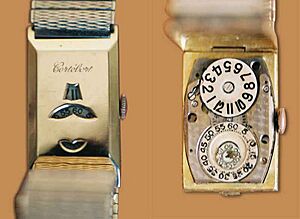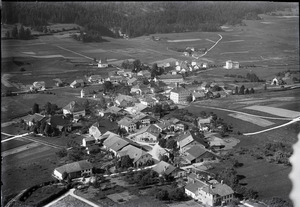Cortébert facts for kids
Quick facts for kids
Cortébert
|
||
|---|---|---|
|
||
| Country | Switzerland | |
| Canton | Bern | |
| District | Jura bernois | |
| Area | ||
| • Total | 14.76 km2 (5.70 sq mi) | |
| Elevation | 680 m (2,230 ft) | |
| Population
(Dec 2020 )
|
||
| • Total | 696 | |
| • Density | 47.15/km2 (122.13/sq mi) | |
| Postal code |
2607
|
|
| Surrounded by | Courtelary, Mont-Tramelan, Corgémont, Nods. | |
Cortébert is a small town, also called a municipality, in Switzerland. It is located in the Jura mountains in the canton of Bern. This area is known as the Jura bernois administrative district. Most people here speak French.
Contents
History of Cortébert
Cortébert was first mentioned in official records in the year 1178. Back then, it was called Cortaibert.
In 1179, important church groups, like the cathedral chapters of Saint-Imier and Moutier-Grandval, owned a lot of land in Cortébert. The village was also part of the Seignory of Erguel. This meant it was controlled by the Diocese of Basel, a powerful church area.
Around 1530, the city of Biel brought the Protestant Reformation to the area. This changed the main religion in Cortébert to Protestantism.
Life in Early Cortébert
For many years, Cortébert had a strong economy based on farming and small workshops. People made things by hand. Many old houses and workshops from the 1500s to the 1800s can still be seen in the village center today.
In 1865, a watch company called Raiguel Juillard et Cie opened a factory in Cortébert. It later became known as Cortébert Watch & Co. This factory completely changed how the village worked and how people earned a living.
Modern Changes and Challenges
With the watch factory, new services came to Cortébert. A village school opened in 1872, but sadly, it and the town's old records were destroyed in a fire in 1959. A train station opened in 1874, making travel easier. A Reformed chapel was built in 1902. In 1938, a pumping station was built to bring water to other villages.
However, the 1930s brought tough times. During the Great Depression, fewer people bought watches. This hit Cortébert's economy very hard. The Cortébert Watch factory struggled and finally closed in 1962. In the 1990s, a new area for factories and shops was created in the west of the village, helping the economy grow again.
Geography of Cortébert
Cortébert covers an area of about 14.78 square kilometers (5.71 square miles). Almost half of this land, about 49.3%, is used for farming. Another large part, 47.7%, is covered by forests. The rest of the land, about 3.2%, has buildings or roads. A very small part, 0.1%, is unproductive land.
Most of the built-up area is for houses and other buildings. The rest is for roads and transportation. In the forests, about 42.2% is dense forest, and 5.5% has orchards or small groups of trees. For farming, 13.3% is used for growing crops, 9.1% for pastures, and 26.8% for mountain pastures.
Cortébert includes the main village and a smaller settlement called Prés de Cortébert, which is a hamlet.
In 2010, Cortébert became part of a new administrative area called Arrondissement administratif Jura bernois. Before that, it was in the District de Courtelary.
Cortébert's Coat of Arms
The blazon (description) of Cortébert's coat of arms is: Argent on a Bend wavy Azure a Trout of the first. This means it shows a silver trout on a wavy blue stripe, all on a silver background. The trout represents the many fish found in the nearby Suze river.
People of Cortébert (Demographics)
Cortébert has a population of about 700 people. As of 2010, about 10.8% of the people living there were from other countries. Over the past ten years (2000–2010), the population has slightly decreased.
Most people in Cortébert speak French as their main language (about 73.8%). German is the second most common language (about 18.6%), followed by Italian (about 3.2%).
In 2008, about 51.8% of the population was male, and 48.2% was female. Many people (about 28.9%) were born in Cortébert. About 31.9% were born in the same canton (Bern), and 17.4% were born elsewhere in Switzerland. About 17.5% were born outside Switzerland.
Young people (0–19 years old) make up about 22.2% of the population. Adults (20–64 years old) make up 60.7%, and seniors (over 64 years old) make up 17.1%.
In 2000, there were 299 single people and 336 married people in Cortébert. There were also 39 widows or widowers and 40 divorced people.
Most apartments (84.4%) in Cortébert are lived in all year round. A small number are used only at certain times of the year (9.1%) or are empty (6.5%).
The population of Cortébert has changed over time. It grew a lot in the late 1800s, reaching over 800 people, then went down and up again. In 2000, it was around 714 people.
Important Sites
The entire village of Cortébert is recognized as an important Swiss Heritage Site. This means its history and buildings are protected.
Economy of Cortébert
In 2011, the unemployment rate in Cortébert was 2.2%. This means most people who wanted jobs had them.
In 2008, 186 people worked in Cortébert. These jobs were in three main areas:
- Primary sector: 50 people worked in this sector, mainly in agriculture (farming). There were 18 businesses in this area.
- Secondary sector: 50 people worked in this sector, mainly in manufacturing (making things) and construction. There were 8 businesses.
- Tertiary sector: 86 people worked in this sector, which includes services. There were 22 businesses.
Many jobs in the service sector were in sales, transportation, hotels, restaurants, education, and healthcare.
In 2000, 32 people traveled into Cortébert for work, while 272 people traveled out of the municipality to work elsewhere. This means more people leave Cortébert for work than come in. About 17.1% of working people used public transportation, and 58.1% used a private car to get to work.
Religion in Cortébert
According to the 2000 census, about 26.1% of the people in Cortébert were Roman Catholic. A larger group, about 50.6%, belonged to the Swiss Reformed Church (Protestant).
There were also smaller numbers of people who were Orthodox Christians, Christian Catholics, or belonged to other Christian churches. About 3.36% of the population was Islamic. There were also a few Buddhists. About 10.36% of the population did not belong to any church or were agnostic or atheist.
Education in Cortébert
Many people in Cortébert have a good education. About 36.7% of the population has finished non-mandatory upper secondary education. About 7.3% have gone on to higher education, like a university.
The school system in the Canton of Bern starts with one year of optional Kindergarten. Then, students go to six years of Primary school. After that, there are three years of lower Secondary school. In secondary school, students are grouped by their abilities. After lower secondary, students can continue their education or start an apprenticeship (learning a trade).
During the 2010–11 school year, 61 students attended classes in Cortébert. There was one kindergarten class with 9 students. The municipality had three primary classes with 51 students. There was also one lower secondary class with one student. Some students in these classes had a different first language than the classroom language.
In 2000, 2 students came to Cortébert to attend school, while 45 students from Cortébert went to schools outside the municipality.
Cortébert has a public library called Bibliothèque communale de Cortébert. In 2008, the library had 1,849 books and other media. It loaned out 1,518 items that year. The library was open for 38 days, averaging 1 hour per week.
Transportation
Cortébert has its own [[railway station, Cortébert]]. The station is on the Biel/Bienne–La Chaux-de-Fonds line. Trains run hourly to Biel/Bienne and La Chaux-de-Fonds.
See also
 In Spanish: Cortébert para niños
In Spanish: Cortébert para niños







